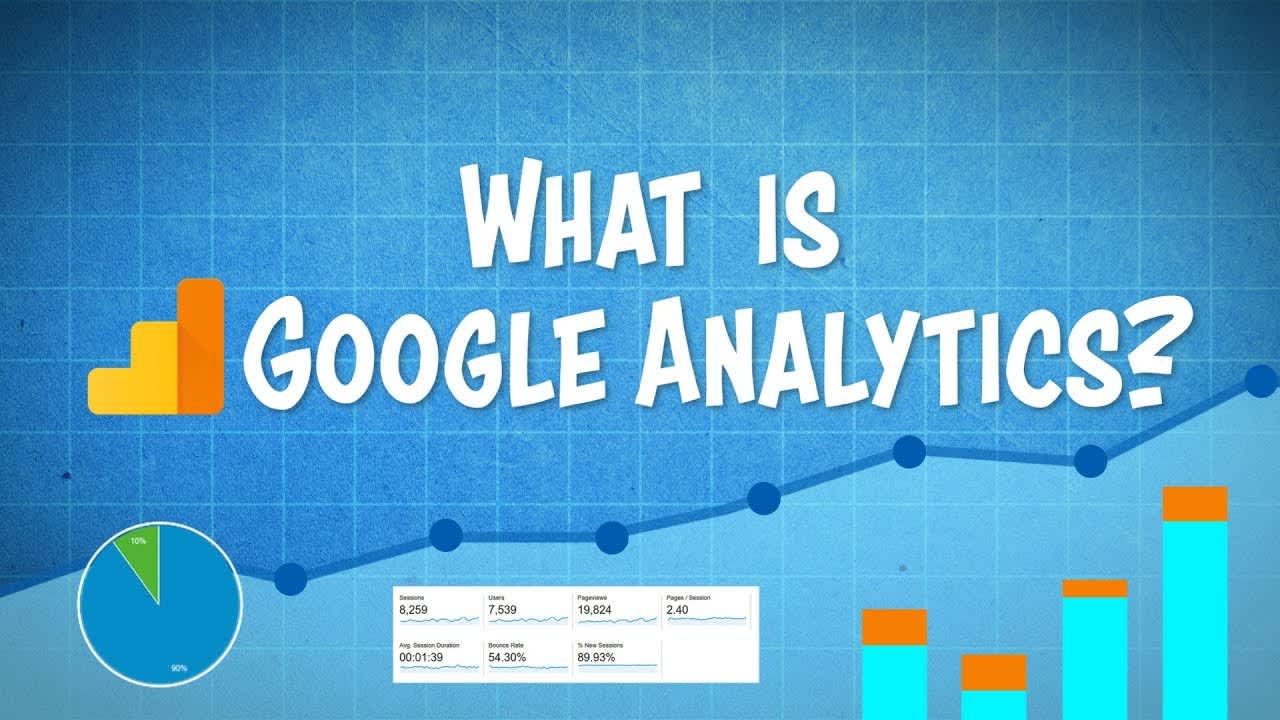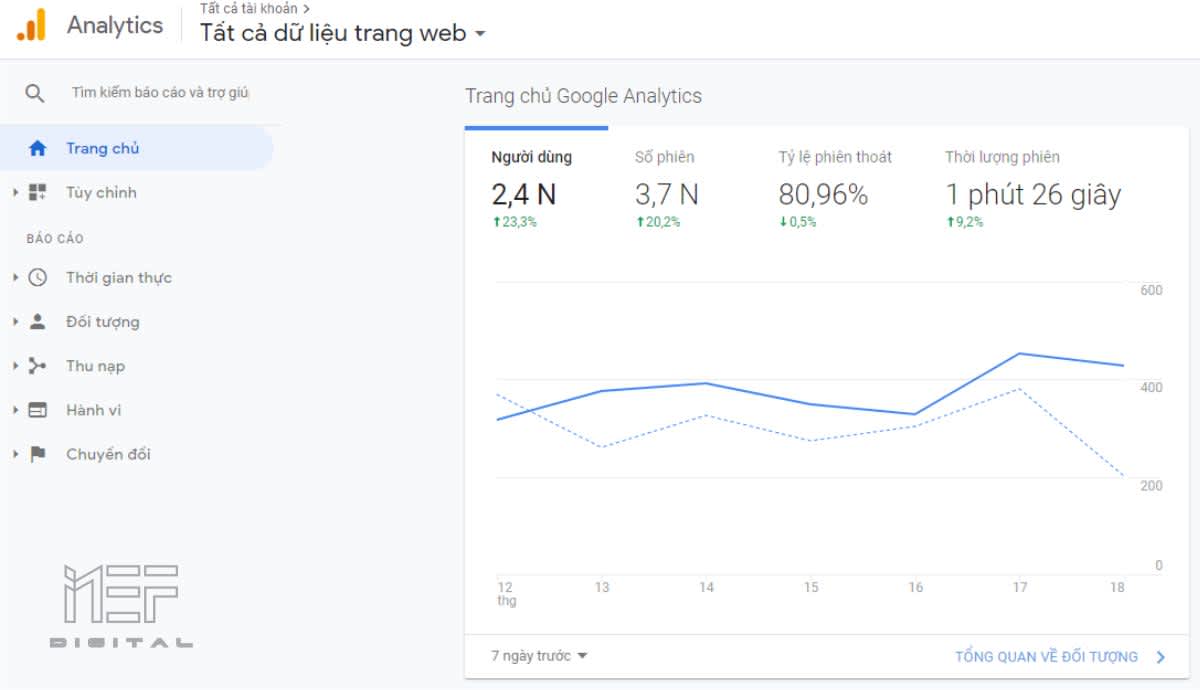
Ever heard of Google Analytics? If your work involves online advertising then surely you will know about it. This is a powerful tool to support the operation of the website.
So do you know about its features and how to use it? The following article will answer all your questions related to Google Analytics.
Introducing Google Analytics
The following presentation will explain to you the concept and use of Google Analytics. These are the basic knowledge you need to grasp first when learning about this field.
What is Google Analytics?
Google Analytics is an online tool for advertisers. Thanks to it, they can track data related to website activities.
Google Analytics always ensures that the data related to the website they provide are accurate. From there, users can have an overview of the status of their website to provide timely solutions in the optimization process. website.
Google Analytics reports website traffic, average visit time, and user bounce rate. In addition, Google Analytics also offers many other indicators, helping you understand the user's surfing behavior.
Google Analytics is a completely free tool, you can register and use it easily as long as you just have your website. Up to now, Google Analytics has been supporting data analysis for over 1 billion websites around the world.
Google Analytics Structure
Google Analytics is currently divided into 3 main parts as follows:
Account (account)
This is not a google account but a top level Google Analytics entity that you can create. Each account contains up to 50 properties. However, few people need to use such a large number of attributes. You need to arrange the properties so that it is as efficient and simple as possible.
Properties
Properties are specific web pages or mobile apps. The tracking ID activates data at the property level it represents. However, properties can be switched between accounts.
View (view)
View is your entry point for reports. Views can be filtered and processed in a certain way. One property can contain up to 25 views.
Outstanding uses of GA
Google Analytics helps you answer the questions you will ask when owning a website of your own. Their specific uses are:
- How many people have visited your website?
- Where did those people come from?
- Is your website mobile-friendly?
- What source does your traffic come from?
- Which marketing tactic generates the highest number of website visits?
- Which part of the website attracts the most users and gets the most visits?
- How many web visitors become potential customers?
How to optimize website speed? - These are just some of the typical questions in a series of user questions that Google Analytics can answer for you. So how to install and use the Google Analytics tool? Please continue reading the following section to get the most accurate usage
- To help you manage and optimize your website more effectively.
Basic GA User Guide
You can install GA in 4 steps and learn about its features. From there, you can easily use it.
4 steps to install Google Analytics tool
Step 1: Create an account
The first requirement is that you have your website. If the website already has the tool installed, you go straight to the login step. If you don't have one, the first thing you need to do is sign up for a Google Analytics account.
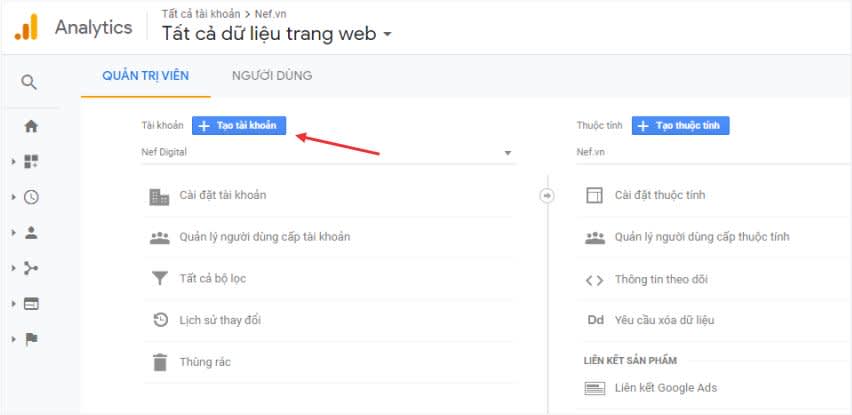
You access the link http://www.google.com.vn/analytics/, sign in with Gmail. Then you click on the create account button and click on the register button on the page that appears afterwards.
Step 2: Set up an account
In this step, you need to fill in the information about the account name and the website you want to track. Specifically, the account name you are free to choose, the URL and website name, the categories related to the website that you already have. In addition, you also need to set the reporting time zone to suit your location.
After completing the information, Google directs you to get the tracking ID. But before that you have to read its terms and conditions and click accept to complete this step. You will then be redirected to the step of getting a tracking ID.
Step 3: Get the tracking ID and paste it on the necessary pages
The google tracking ID is a JavaScript code provided to the user. This code exists for the purpose of collecting data from the website and sending it to Google Analytics for statistics.
Your job is to copy this code and paste it into the pages you need to track on your website or use it for Google tag manager. The place for you to paste into web pages is where the HTML code is located, before the tag .
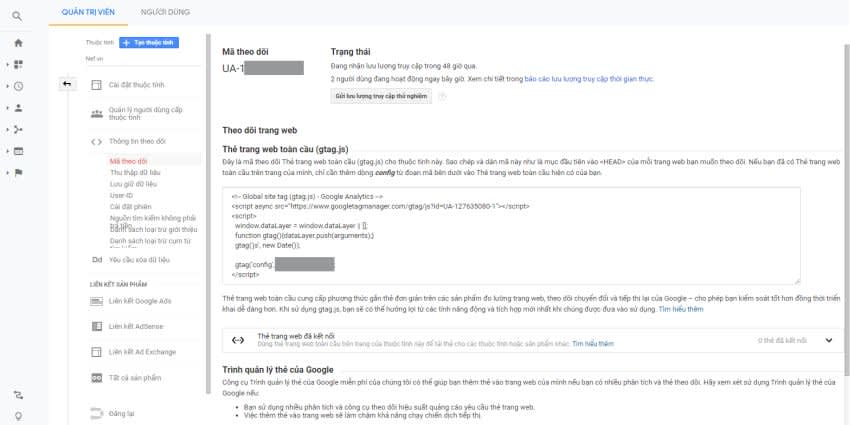
Step 4: Set goals
The very necessary work after installing the basic information is setting goals. You can find the goal setting section in the admin link at the top of the Google Analytics page. Then you click on Goals in your website.
Setting goals helps Google Analytics understand what it has to do with the site. From there, Google Analytics extracts the data you want. The steps you need to do in goal setting are:
- Click “new goal”
- Select “custom”
- Click “next step”
- Name the target as you like
- Select "destination"
- Enter the website URL in the destination field
- Press save
- You can create up to 20 goals, with each of you following the steps above. The goals you can set include email list signup, lead form submission, complete purchase, etc. Depending on the purpose of your website you may have different goals.
Reference tool: Google Search Console
5 main features of Google Analytics that you need to know
Google Analytics has 5 main features as follows.
Real time – Real time
The real-time feature tells you about the number of visitors to your website at the moment. In addition, this feature also retrieves the following information:
- What channel are the guests coming from?
- What pages in the web are visitors visiting?
- Location of visitors when visiting
- Keywords shown to customers
- What conversions are done?
- Where does the URL come from?
- Monitoring real-time metrics helps you know if the website is stable or not, so that you can take timely action.
Audience – Visitors to the website
Audience gives you detailed customer information at all times. Those parameters are:
- User: Total number of people who visited in a specified time
- New user: Number of new users who visited the website during a specified time
- Sessions: Sessions, usually 30 minutes counts as a session
- Session per User: Number of sessions per user
- Pageviews: Total number of views viewed by visitors, including repeat views
- Pages/ Session: Total number of pages viewed in 1 session
- Average Session Duration: Average time of 1 session
- Bounce rate: The bounce rate of users when accessing and not interacting with any content on the website
- Language
- Geographical location
- Browser (chrome, firefox, mug cup, ...)
- Mobile and desktop operating systems
- How users act on the web, where does it start and end?
In general, Audience helps you visualize and classify customers according to common characteristics. From there, you can come up with a plan to optimize the experience, upgrade the index, create credibility from google and upgrade the website level.
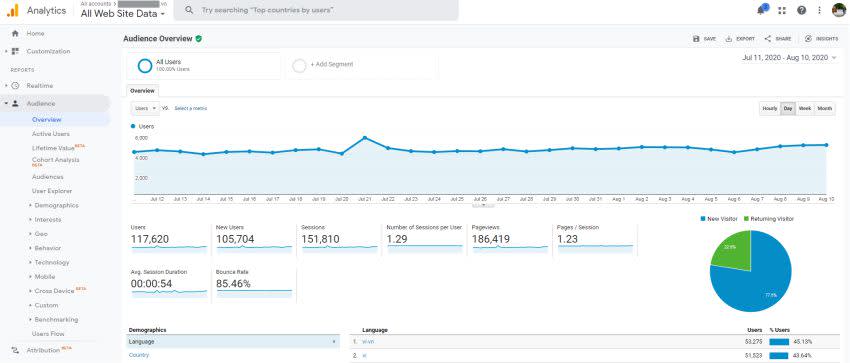
Acquisition – Traffic
Acquisition helps you get an overview of the traffic of online marketing channels. There are 6 channels are:
- Organic Search: Search channel on google
- Paid Search: Advertising channel
- Direct: Channel where users directly access the website
- Social: Content shared on social networks directs users to the website
- Referral: Content brought back from other websites
- Other: some places have not been classified by google as zalo
- Traffic from any channel is equally valuable. However, Organic Search is an indicator you should pay attention to if you are doing an SEO campaign.
Behavior – Customer behavior
Behavior helps webmasters better understand customer behavior. These include:
- What content gets the most views: Pages, titles, or keywords
- Time on page
- Bounce rate
- Page load speed: is the time it takes for users to load web content on pages
- Search on the page (customers search using the search function)
Conversion – Conversion value
What businesses are interested in is selling goods (buy), customer data (lead), calls (calls), ... in general, conversion values. For marketing campaigns, to measure effectively, you need to identify these metrics.
By setting up a counter based on customer actions such as filling out forms, calling, purchasing, etc., Google Analytics will show you how many customers converted during the campaign period. From there, we can measure the effectiveness of advertising campaigns.
For SEOs, being familiar with the Google Analytics tool is a must. This tool not only helps you optimize your website's SEO for search engines, but also helps you maximize profits from customers finding your website.
Above is the information about the Google Analytics tool that we want to send to our readers. Hopefully the article has brought you the most useful knowledge so that you can apply it most effectively.
Content summary:
What is Google Analytics?
Google Analytics is an online tool for advertisers. Thanks to it, they can track data related to website activities.
Google Analytics Structure
Account (account)
Properties
View (view)
4 steps to install Google Analytics tool
Step 1: Create an account
Step 2: Set up an account
Step 3: Get the tracking ID and paste it on the necessary pages
Step 4: Set goals
5 main features of Google Analytics that you need to know
Real time – Real time
Audience – Visitors to the website
Acquisition – Traffic
Behavior – Customer behavior
Conversion – Conversion value
